Greek mythology’s Gigantomachy pits giants against the Olympian gods
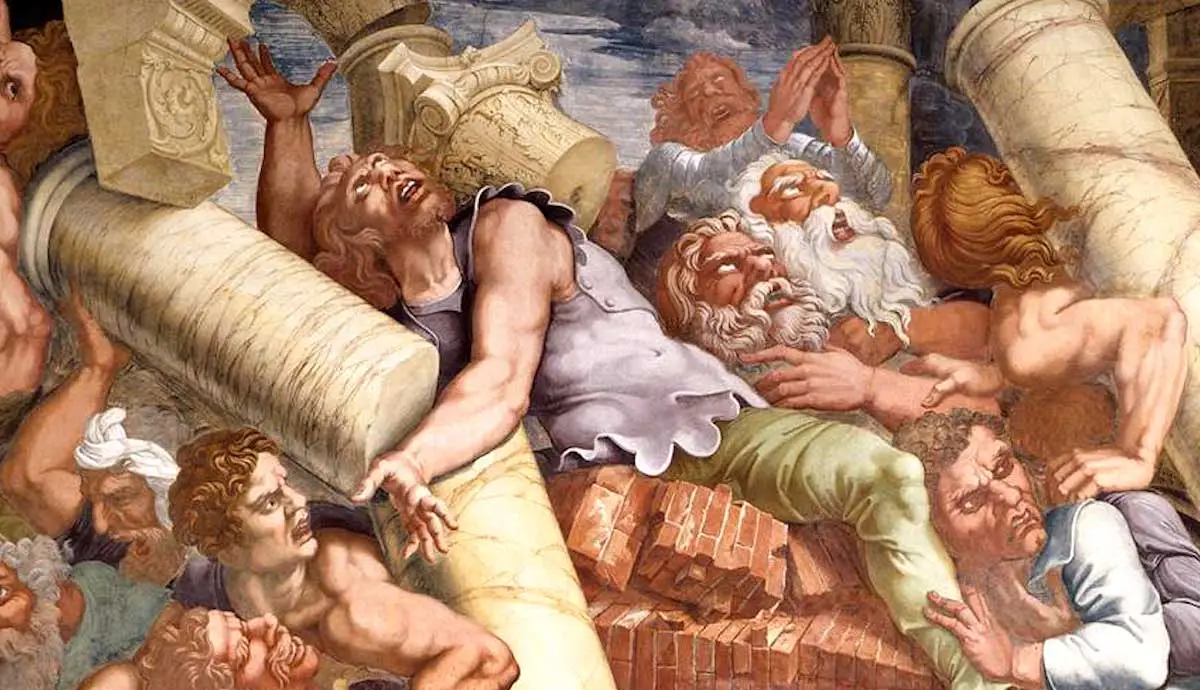
The Gigantomachy was a follow-up to the Titanomachy, the greatest battle in Greek mythology.
The Gigantomachy, also known as the War of the Giants, was a significant conflict that took place after the Titanomachy in Greek mythology. It was a fiercely fought battle driven by the Giants’ desire to overthrow the Olympian gods and establish their own dominion. The Giants harbored resentment towards the Olympians and sought to reclaim what they believed was rightfully theirs. This epic battle holds a prominent position in Greek Mythology and is recounted in various ancient texts, including Hesiod’s Theogony and Homer’s epic poems. But who exactly were the Giants, and what were their exact motivations for rebelling against the Olympian gods? Let us delve deeper into these questions.
1. Who Were the Giants?
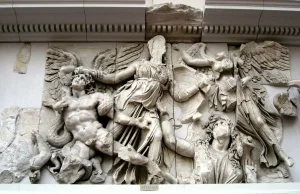
The Giant Alcyoneus (far left) in the Pergamon Frieze, via Wikimedia Commons
Before we delve into the events of the Gigantomachy, let’s explore who the Giants were in Greek mythology. The Giants, or Gigantes, were formidable and monstrous beings who emerged from the blood of Uranus when he was castrated by Gaia. Belonging to the older generation of gods, they were considered children of Gaia and Uranus.
The Giants possessed immense size, strength, and often had multiple heads or limbs, which can be seen as symbolizing their fearsome nature. They were associated with primal forces of nature and were believed to embody chaos, disorder, and untamed elements. Their existence was intertwined with earthquakes, volcanic eruptions, and other natural catastrophes.
Depictions of the Giants can be found in various ancient texts and artistic representations, including works such as Hesiod’s Theogony and the Homeric epics. They hold a significant place in Greek Mythology, representing the eternal struggle between order and chaos, as well as the ongoing conflict between the gods and the primordial forces of the earth.
The most renowned conflict involving the Giants is the Gigantomachy. This epic clash symbolized the struggle between civilization and chaos. As “offspring” of the first generation of gods, the Giants rebelled against the Olympian gods (led by Zeus) after the events of the Titanomachy, aiming to challenge their authority and overthrow their rule.
The Gigantomachy happened in the aftermath of the Titanomachy, which was considered the most intense battle in Greek Mythology. The Titanomachy was a conflict between the second and third generations of gods, namely the Titans and the Olympians. The Giants felt slighted after the victory of the Olympians and wanted to retake what they believed belonged to them. The cause of the Gigantomachy and its outcome will be explored in the rest of this article.
2. Was the Titanomachy the Cause of the Gigantomachy?
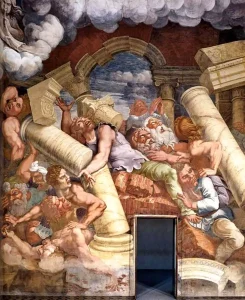
Detail of the Sala dei Giganti (Chamber of the Giants) in the Palazzo del Te, by Giulio Romano, 1532
The Titanomachy refers to the brutal battle for the throne in Greek mythology, fought between Zeus and his father Cronus. Cronus, having overthrown his father Uranus, faced a prophecy that one of his sons would dethrone him, just as he had done to his father Uranus. To prevent this fate, Cronus imprisoned his siblings, the Titans, in the deepest and darkest part of the underworld known as Tartarus. He also devoured his children, drawing the ire of his wife Rhea.
However, Rhea, Cronus’ wife, managed to save their youngest son, Zeus. She hid Zeus in a cave on the island of Crete, where he was cared for by a goat named Amalthea. As Zeus grew older, he sneakily served as Cronus’ cupbearer while hiding his identity. He used this opportunity to concoct a poisonous drink that made Cronus regurgitate all the children he had previously eaten. With all his siblings freed, Zeus rallied them together and convinced them to confront their father in battle, initiating the Titanomachy.
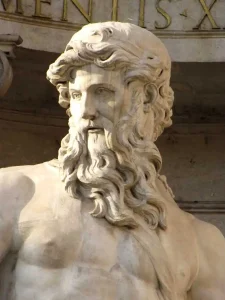
Sculpture of Uranus, the first god of the sky, wia GreekMythology.com
Zeus then freed the Hecatoncheires and the Cyclops from the Tartarus, where they had been imprisoned by his father Uranus. Seeking assistance against his father, Zeus requested their help, and they agreed. The Hecatoncheires were a kind of Giant, and they launched barrages of stones at the Titans to help with the battle. The Cyclops helped by forging Zeus’s signature lightning bolt. Some of the Titans allied with Zeus, while others, such as Atlas, took Cronus’s side.
The Titanomachy lasted a decade and consisted of numerous fierce battles and confrontations between Cronus, the Titans, and the Olympian gods. It was a monumental struggle for dominion and control over the cosmos. The Titans, renowned for their immense power and strength, proved to be formidable opponents. However, in the end, the Olympian gods emerged as the victors.
Regarding the Gigantomachy, it is important to note that the Giants rebelled strongly against the authority of the Olympian gods and were eager to overthrow their rule. After the Titanomachy concluded with the triumph of the Olympians, the Giants, driven by their longstanding desire for power, immediately initiated a battle against the Olympians. While the Titanomachy did not directly cause the Gigantomachy, it served as a motivation for the long-awaited conflict to commence.
3. What Happened During the Gigantomachy?
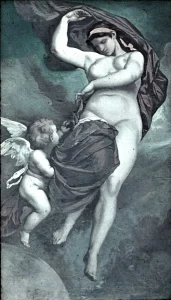
Ceiling paining of Gaia in Academy of Fine Arts Vienna, by Anselm Feuerbach, 1875, via Bild Index
Following the Titans’ defeat, Gaia harbored intense anger due to what happened to her son Cronus, and because of this, she incited the Giants to wage war against the Olympian gods. Although the Giants lacked the means to directly challenge the new gods, they wreaked havoc wherever they went, displaying unstoppable and invincible might. However, Zeus discovered their vulnerability: only a demigod had the power to vanquish them. Because of this, he instructed Athena to summon Heracles, a renowned demigod known for his strength. Heracles heeded Athena’s call and, wielding an arrow dipped in the poisonous blood of the Hydra, he struck down the giant Alcyoneus, causing him to fall; the giant was immortal within the confines of his hometown, Pallene. Heracles then dragged Alcyoneus out beyond the borders of Pallen, where the Giants’ wasn’t immortal anymore.
In the war against the Giants, Zeus once again had the support of Poseidon, Apollo, and Hephaestus, as he had during the Titanomachy. However, the decisive factor for victory was Heracles’ involvement. Armed with his lethal arrows, Heracles eliminated numerous Giants, complementing Zeus’ lightning strikes with ground-based combat. Thanks to these collaborative efforts, the Giants were defeated, ensuring the continued reign of the Olympian gods.
The final threat to Zeus’ authority came in the form of Typhoeus, a monstrous creature with a hundred serpent-like heads, born of Gaia and Tartarus. However, Zeus emerged triumphant, securing his absolute power as the supreme god. Alongside his brothers Poseidon and Hades, Zeus divided the universe between his siblings — Zeus claiming the sky, Poseidon ruling the seas, and Hades governing the underworld.
4. What Happened to the Giants after their Defeat?
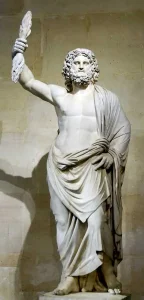
Sculpture showing Zeus holding a thunderbolt, via unknown artist, via Louvre
Following their defeat in the Gigantomachy, the fate of the Giants in Greek Mythology varies in different accounts and traditions. Greek Mythology often presents diverse versions of stories, and the specific details can differ based on the source of the specific recounting of the myth.
According to certain sources, the surviving Giants were condemned to eternal imprisonment in Tartarus, the deepest part of the Underworld. Tartarus served as a place of punishment for the most wicked and monstrous beings, and it became the cosmic prison for those who dared to challenge the gods.
Alternatively, another version of the myth suggests that the Giants underwent a transformation, either by the hands of Zeus or the goddess Athena. This transformation turned them into stone, transforming them into geological features such as mountains, hills, or rocky formations. These stone formations were believed to serve as lasting reminders of the Giants’ defeat and as evidence of the gods’ power.
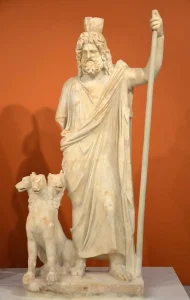
Hades, god of the underworld, mid-2nd century CE, via Wikipedia Commons
According to a third interpretation, the Giants were simply all slain by the gods during the Gigantomachy. Their bodies were scattered, and their souls were condemned to the underworld, where they faced eternal punishment. This version of the myth implies a complete eradication of the Giants, leaving no possibility for their resurgence.
The Gigantomachy holds profound spiritual and philosophical significance, representing the perpetual struggle between opposing forces within myth. It symbolizes the eternal clash between order and chaos, civilization, and primal forces. The Olympian gods’ triumph over the Giants signifies the establishment of cosmic order and the attainment of harmonious balance in the universe. The defeat of the Giants stands as a poignant reminder of the formidable power wielded by the gods and the consequences of challenging their authority.